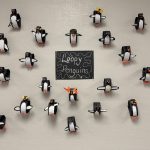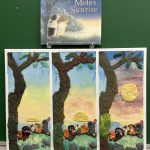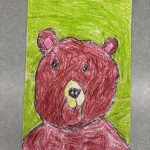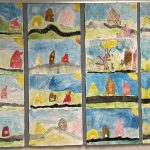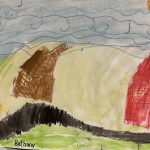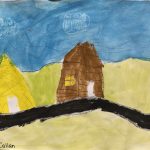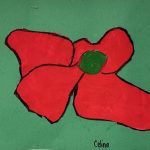We had fun creating these ‘loopy’ penguins out of different sized strips of construction paper. Some students turned theirs into a specific variety: Emperor, Adelie, Macaroni, and Rockhopper.
Category: Art Programme
Arts Alive – BAG Gratitude in the Little Things
For our Art piece we were inspired by the book “Mole’s Sunrise”, by Jeanne Willis. In this story Mole goes to see his very first sunrise with his friends Vole, Squirrel, Sparrow, and Rabbit. Their vivid descriptions bring forth a clear picture for Mole. In the end we learn that Mole is blind and has witnessed this sunrise in his mind. We had a very thoughtful discussion about the book.
We took an 18” x 24” canvas and divided it into three panels with artist’s tape. We used acrylic paints (which one group mixed and blended) to paint the background areas on the three panels. While this was happening the other group took various colours of modelling clay and created the colours needed for the trees, branches, leaves, rocks, and the suns.
Painting happened first.
The next day the modelling clay crew took over in stages and attached the modelling clay to the canvas to create their objects.
Five students created three of the same animals.
It all came together this afternoon. We then took off the border tapes.
The student are very pleased with their finished work. It is heading off to the Burnaby Art Gallery on Thursday.
The Opening Night of the exhibition will be on Thursday, May 1st. All the participating school’s art pieces will be on display there until June 1.
Cinderella Penguins
The Three Bears … and some of their friends.
The Houses of the Three Little Pigs
Goldilocks was Naughty
Clay Snow People
Students enjoyed the long, but rewarding, experience of creating these lovely art pieces. The first step was taking the natural earthen clay and forming the three sections around a wooden doweling. They pinched out a ‘carrot’ nose. They used more clay to create hats. After the clay dried out (about a week) the pieces were fired into bisque. The bisque was then glazed. The snow people were glazed white with the noses made orange. Students were able to choose different colours for their hats. The hats were glazed on top of their snow people. When everything was out of the kiln students added twigs (for arms). They also created felt scarves. Google eyes, pom poms, and the scarves were hot glue gunned on and the snow people were complete.

